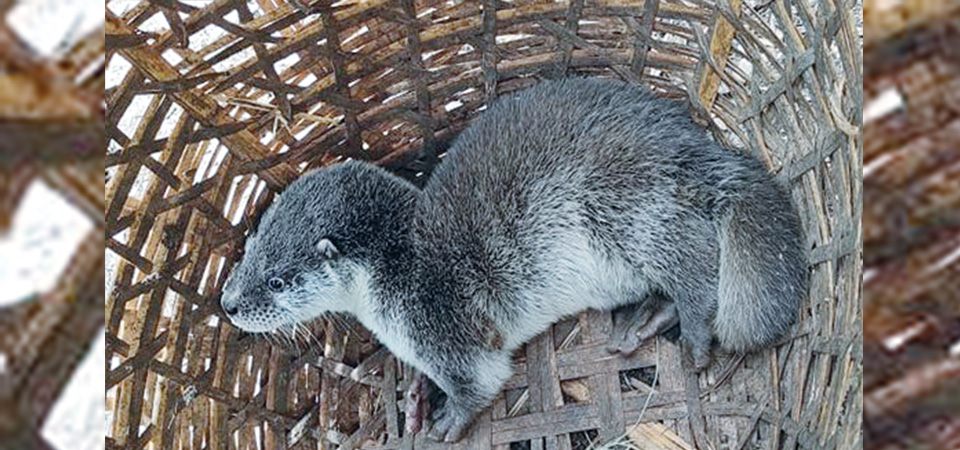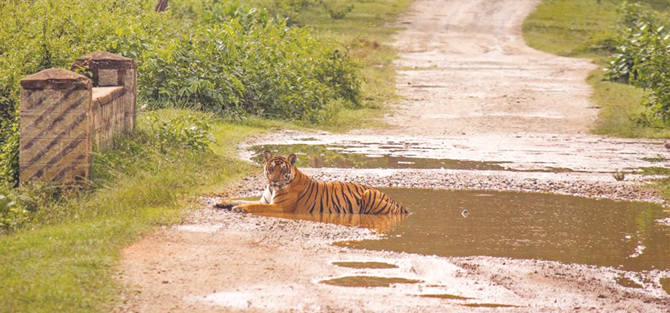European otter found in three locations of Nepal

Kathmandu, Feb. 5: The Eurasian otter, also known as European otter (Lutra lutra), an endangered species categorized as Near Threatened in the IUCN Red List, has been recorded as the first evidence in three districts of Nepal in three decades.
A group of conservationists have found Eurasian otter in Rukum, Jajarkot and Kavre and its detailed scientific article “First Evidence of Eurasian Otter in Nepal in Three Decades” has been published.
Otter is a beautiful creature that lives in water. Fish is the most preferred choice of food. Although fish is the main food, it also eats frogs, birds, and other aquatic invertebrates.
Conservationist Mohan Bikram Shrestha, otter researcher, said that cameras trapped images from the Barekot River in Jajarkot district, photographic images from Tubang River in the East Rukum district, and the skull of a dead otter are gathered evidence as proof.
The research was conducted by a team led by Shrestha. Various field visits have been carried out since 2019 and the study presents the first evidence of Eurasian otter’s presence in Nepal since 1991.
“The camera trap images from these three districts confirm the continued presence of Eurasian otters in the hill streams in Nepal. Further study would explain the distribution of Eurasian otters in this region,” Shrestha said.
A public awareness programme for duck farmers and villagers along the Roshi River, including a sensitization workshop for local conservation authorities, would help to conserve this rare species in Nepal, Shrestha said.
The presence of Eurasian otters was reported from Rara Lake in 1976 and both Rupa and Begnas Lakes with photographic evidence in 1991, but a study in 2008 and later in 2018 found no presence of otters in those lakes, according to the research paper.
Anecdotally, the presence of Eurasian otter was suggested in protected areas such as the Annapurna Conservation Area, Makalu Braun National Park, Bardia National Park, Rara National Park and outside protected areas in Saptari, Chitwan, Kapilvastu, Bardia, Kailali, Kanchanpur, Bajhang, Bajura, Ilam, Panchthar, Taplejung and Sankhuwasabha districts, and other various districts of Terai and hills, however, these presence reports are based on indirect signs and through the public reports without verifiable evidence, the research clarified.
From 1989 to 2017, it is seen that 755 pieces of skin had been recovered, which indicates that illegal pelt trade threatened the species in Nepal.
However, there is a dilemma as to whether those skins were killed
in Nepal or they were brought from India by poachers. Because some species of otter found in Nepal are also found in India.
There are three species of otter found in Nepal out of 13 species found across the world. Three species locally called Kaalo oot (Eurasian otter), Khairo oot (smooth-coated otter), and Sano oot (Asian small otter) are found in Nepal. According to various findings, Khairo oots are found in Shuklaphanta, Banke, Koshi, Bardia, Chitwan and other areas.
According to Shrestha, anthropogenic disturbances, natural habitat degradation, sand and stone extraction from rivers, overfishing, shoreline vegetation removal, livestock grazing, irrigation canal and dam construction, frequent human activity on the river bank, industrial and agricultural pollution are the causes leading to the decline in the number of Eurasian otters in Nepal.
According to various studies, most species that are victims of population decline or a loss of habitat tend to eventually lose their genetic difference due to inbreeding from small populations. A study conducted in 2001 examined whether or not the populations of Eurasian otters suffered from a lack of genetic variability.
Recent News

Do not make expressions casting dout on election: EC
14 Apr, 2022
CM Bhatta says may New Year 2079 BS inspire positive thinking
14 Apr, 2022
Three new cases, 44 recoveries in 24 hours
14 Apr, 2022
689 climbers of 84 teams so far acquire permits for climbing various peaks this spring season
14 Apr, 2022
How the rising cost of living crisis is impacting Nepal
14 Apr, 2022
US military confirms an interstellar meteor collided with Earth
14 Apr, 2022
Valneva Covid vaccine approved for use in UK
14 Apr, 2022
Chair Prachanda highlights need of unity among Maoist, Communist forces
14 Apr, 2022
Ranbir Kapoor and Alia Bhatt: Bollywood toasts star couple on wedding
14 Apr, 2022
President Bhandari confers decorations (Photo Feature)
14 Apr, 2022









